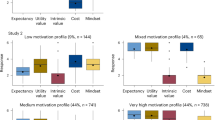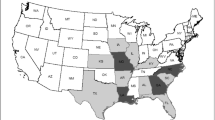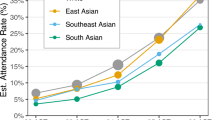Abstract
Educational disparities remain a key contributor to increasing social and wealth inequalities. To address this, researchers and policymakers have focused on average differences between racial groups or differences among students who are falling behind1. This focus potentially leads to educational triage, diverting resources away from high-achieving students, including those from racial minorities2,3. Here we focus on the ‘racial excellence gap’—the difference in the likelihood that students from racial minorities (Black and Hispanic) reach the highest levels of academic achievement compared with their non-minority (white and Asian) peers. There is a shortage of evidence that systematically measures the magnitude of the excellence gap and how it evolves4,5. Using longitudinal, statewide, administrative data, we document eight facts regarding the excellence gap from third grade (typically ages 8–9) to high school (typically ages 14–18), link the stability of excellence gaps and student backgrounds, and assess the efficacy of public policies. We show that excellence gaps in maths and reading are evident by the third grade and grow slightly over time, especially for female students. About one third of the gap is explained by a student’s socioeconomic status, and about one tenth is explained by the school environment. Top-achieving racial minority students are also less likely to persist in excellence as they progress through school. Moreover, state accountability policies that direct additional resources to reduce non-race-based inequality6 had minimal effects on the racial excellence gaps. Documenting these patterns is an important step towards eliminating excellence gaps and removing the ‘racial glass ceiling’.
This is a preview of subscription content, access via your institution
Access options
Access Nature and 54 other Nature Portfolio journals
Get Nature+, our best-value online-access subscription
$32.99 / 30 days
cancel any time
Subscribe to this journal
Receive 51 print issues and online access
$199.00 per year
only $3.90 per issue
Buy this article
- Purchase on SpringerLink
- Instant access to full article PDF
Prices may be subject to local taxes which are calculated during checkout






Similar content being viewed by others
Data availability
This research used data structured and maintained by the MERI–Michigan Education Data Center (MEDC). MEDC data are modified for analysis purposes using rules governed by MEDC and are not identical to those data collected and maintained by the Michigan Department of Education (MDE) and/or Michigan’s Center for Educational Performance and Information (CEPI). Results, information and opinions solely represent the analysis, information and opinions of the authors and are not endorsed by, or reflect the views or positions of, grantors, MDE and CEPI or any employee thereof. Researchers interested in accessing these data can submit a request to MEDC through https://medc.miedresearch.org. There are no constraints to submit a proposal.
Code availability
Code used in this paper will be publicly available at https://www.openicpsr.org/openicpsr/project/215681/version/V1/view.
References
Hanushek, E. A., Peterson, P. E., Talpey, L. M. & Woessmann, L. The achievement gap fails to close. Educ. Next 19, 8–17 (2019).
Gillborn, D. & Youdell, D. Rationing Education: Policy, Practice, Reform, and Equity (McGraw-Hill Education, 1999).
Neal, D. & Schanzenbach, D. W. Left behind by design: proficiency counts and test-based accountability. Rev. Econ. Stat. 92, 263–283 (2010).
Plucker, J. A., Burroughs, N. & Song, R. Mind the (Other) Gap! The Growing Excellence Gap in K-12 Education (Center for Evaluation and Education Policy, Indiana Univ., 2010).
Rambo-Hernandez, K. E., Peters, S. J. & Plucker, J. A. Quantifying and exploring elementary school excellence gaps across schools and time. J. Adv. Acad. 30, 383–415 (2019).
Hemelt, S. W. & Jacob, B. A. How does an accountability program that targets achievement gaps affect student performance? Educ. Finance Policy 15, 45–74 (2020).
Kober, N. It Takes More than Testing: Closing the Achievement Gap. A Report of the Center on Education Policy (Center on Education Policy, 2001).
Williams, B. Closing the Achievement Gap: A Vision for Changing Beliefs and Practices (ASCD, 1996).
Ladson-Billings, G. From the achievement gap to the education debt: understanding achievement in us schools. Educ. Res. 35, 3–12 (2006).
Magnuson, K. A. & Waldfogel, J. Early childhood care and education: effects on ethnic and racial gaps in school readiness. Future Child. 15, 169–196 (2005).
Darling-Hammond, L. Race, inequality and educational accountability: the irony of ‘no child left behind’. Race Ethn. Educ. 10, 245–260 (2007).
Gamoran, A. Standards-Based Reform and the Poverty Gap: Lessons for “No Child Left Behind” (Brookings Institution Press, 2008).
Murnane, R. J. Improving the education of children living in poverty. Future Child. 17, 161–182 (2007).
Paige, R. No Child Left Behind: The ongoing movement for public education reform. Harvard Educ. Rev. 76, 461–473 (2006).
Booher-Jennings, J. Below the bubble: “educational triage” and the Texas accountability system. Am. Educ. Res. J. 42, 231–268 (2005).
Wyner, J. S., Bridgeland, J. M. & DiIulio Jr, J. J. Achievementrap: How America is Failing Millions of High-achieving Students from Lower-Income Families (Civic Enterprises, 2007).
Hoxby, C. M. & Avery, C. The Missing “One-offs”: The Hidden Supply of High-Achieving, Low Income Students (National Bureau of Economic Research, 2013).
Meinck, S. & Brese, F. Trends in gender gaps: using 20 years of evidence from TIMSS. Large Scale Assess. Educ. 7, 8 (2019).
Plucker, J., Hardesty, J. & Burroughs, N. Talent on the Sidelines: Excellence Gaps and America’s Persistent Talent Underclass (Center for Education Policy Analysis, Univ. of Connecticut, 2013).
Guryan, J., Hurst, E. & Kearney, M. Parental education and parental time with children. J. Econ. Perspect. 22, 23–46 (2008).
Hanushek, E. A. & Rivkin, S. G. Harming the best: how schools affect the black-white achievement gap. J. Pol. Anal. Manag. 28, 366–393 (2009).
Meyer, M. S., Shen, Y. & Plucker, J. A. Reducing excellence gaps: a systematic review of research on equity in advanced education. Rev. Educ. Res. 94, 33–72 (2024).
Plucker, J. A., Peters, S. J. & Schmalensee, S. Reducing excellence gaps: a research-based model. Gifted Child Today 40, 245–250 (2017).
Plucker, J. A. & Peters, S. J. Excellence Gaps in Education: Expanding Opportunities for Talented Students (Harvard Education Press, 2020).
Kim, J., Watkins, S. & Yoon, S. W. Social justice alert: future innovators and leaders fall behind in academic achievement. Educ. Leader. Rev. 17, 129–141 (2016).
Hamilton, R. et al. Disentangling the roles of institutional and individual poverty in the identification of gifted students. Gifted Child Q. 62, 6–24 (2018).
Kaul, C. R. & Davis, B. K. How the state education agencies addressed gifted education in the title II sections of their ESSA state plans. Gifted Child Today 41, 159–167 (2018).
Hodges, J. & Lamb, K. Washington’s high-ability programs during the no child left behind era. J. Educ. Gifted 42, 283–302 (2019).
Peters, S. J., Gentry, M., Whiting, G. W. & McBee, M. T. Who gets served in gifted education? demographic representation and a call for action. Gifted Child Q. 63, 273–287 (2019).
Turner, E. O. & Spain, A. K. The multiple meanings of (in)equity: remaking school district tracking policy in an era of budget cuts and accountability. Urban Educ. 55, 783–812 (2020).
Mun, R. U., Ezzani, M. D., Lee, L. E. & Ottwein, J. K. Building systemic capacity to improve identification and services in gifted education: a case study of one district. Gifted Child Q. 65, 132–152 (2021).
Lockhart, K., Meyer, M. S. & Crutchfield, K. A content analysis of selected state plans for gifted and talented education. J. Adv. Acad. 33, 3–42 (2022).
List, J. A. Non est Disputandum de Generalizability? A Glimpse Into the External Validity Trial (National Bureau of Economic Research, 2020).
Hyman, J. Act for all: the effect of mandatory college entrance exams on postsecondary attainment and choice. Educ. Fin. Pol. 12, 281–311 (2017).
Fryer, R. G. & Levitt, S. D. Testing for racial differences in the mental ability of young children. Am. Econ. Rev. 103, 981–1005 (2013).
List, J. A., Pernaudet, J. & Suskind, D. L. Shifting parental beliefs about child development to foster parental investments and improve school readiness outcomes. Nat. Commun. 12, 1367–1378 (2021).
Bond, T. N. & Lang, K. The black-white education scaled test-score gap in grades K-7. J. Hum. Resour. 53, 891–917 (2018).
Gelbach, J. B. When do covariates matter? and which ones, and how much? J. Labor Econ. 34, 509–543 (2016).
Autor, D., Figlio, D., Karbownik, K., Roth, J. & Wasserman, M. Males at the tails: how socioeconomic status shapes the gender gap. Econ. J. 133, 3136–3152 (2023).
Jackson, C. K. & Mackevicius, C. L. What impacts can we expect from school spending policy? evidence from evaluations in the United States. Am. Econ. J. 16, 412–446 (2024).
Reardon, S. F., Kalogrides, D. & Shores, K. The geography of racial/ethnic test score gaps. Am. J. Sociol. 124, 1164–1221 (2019).
Hemelt, S. W. & Jacob, B. Differentiated Accountability and Education Production: Evidence from NCLB Waivers (National Bureau of Economic Research, 2017).
Cattaneo, M. D., Jansson, M. & Ma, X. Simple local polynomial density estimators. J. Am. Stat. Assoc. 115, 1449–1455 (2020).
Hess, F. M. & Rotherham, A. J. Can NCLB survive the competitiveness competition? Sch. Bus. Aff. 74, 8 (2008).
Card, D. & Giuliano, L. Universal screening increases the representation of low-income and minority students in gifted education. Proc. Natl Acad. Sci. USA 113, 13678–13683 (2016).
Assouline, S. G., Ihrig, L. M. & Mahatmya, D. Closing the excellence gap: investigation of an expanded talent search model for student selection into an extracurricular stem program in rural middle schools. Gifted Child Q. 61, 250–261 (2017).
Ihrig, L. M., Lane, E., Mahatmya, D. & Assouline, S. G. Stem excellence and leadership program: increasing the level of stem challenge and engagement for high-achieving students in economically disadvantaged rural communities. J. Educ. Gifted 41, 24–42 (2018).
Calonico, S., Cattaneo, M. D., Farrell, M. H. & Titiunik, R. rdrobust: Software for regression-discontinuity designs. Stata J. 17, 372–404 (2017).
Calonico, S., Cattaneo, M. D. & Titiunik, R. Robust nonparametric confidence intervals for regression-discontinuity designs. Econometrica 82, 2295–2326 (2014).
Hartman, E. Equivalence testing for regression discontinuity designs. Polit. Anal. 29, 505–521 (2021).
White, R. & DeGrow, B. A Survey of Michigan’s Private Education Sector. A Mackinac Center Report (ERIC, 2016).
List, J. A., Shaikh, A. M. & Vayalinkal, A. Multiple testing with covariate adjustment in experimental economics. J. Appl. Econometrics 38, 920–939 (2023).
Kline, P., Rose, E. K. & Walters, C. R. Systemic discrimination among large US employers. Q. J. Econ. 137, 1963–2036 (2022).
Hartman, E. RDD equivalence test. Github https://github.com/ekhartman/rdd_equivalence/blob/master/RDD_equivalence_functions.R?raw=TRUE (2020).
Cattaneo, M. D., Idrobo, N. & Titiunik, R. A Practical Introduction to Regression Discontinuity Designs: Foundations (Cambridge Univ. Press, 2019).
Acknowledgements
The authors thank D. Neal and P. Peña for helpful comments; S. Hemelt and B. Jacob for sharing their code; G. Barcelo, C. Brobst, J. Cipriano, Z. El-Kaissi, B. Hammer, A. Listo, A. Mryan, F. Pagnotta, L. Ramirez, S. Shi, R. Sharma, C. Smith and J. Wang for research assistance with the literature review.
Author information
Authors and Affiliations
Contributions
J.A.L., M.S.L. and H.U. conceived the research questions and acquired the data. U.K., J.A.L., A.S. and H.U. formulated the methodological approach, and U.K., A.S. and H.U. analysed the data. U.K., A.S., J.A.L. and H.U. wrote the manuscript. The authors are listed in alphabetical order.
Corresponding authors
Ethics declarations
Competing interests
The authors declare no competing interests.
Peer review
Peer review information
Nature thanks Aline Bütikofer, Jonathan Plucker, Ariella Spitzer and the other, anonymous, reviewer(s) for their contribution to the peer review of this work.
Additional information
Publisher’s note Springer Nature remains neutral with regard to jurisdictional claims in published maps and institutional affiliations.
Extended data figures and tables
Extended Data Fig. 1 Percentage change in excellence gap from 3rd grade.
This figure displays the percentage change in this difference between minority status in reaching excellence, relative to the difference in the 3rd grade. Excellence is defined as reaching the top decile on the math statewide standardized exam, MEAP for all years until 2014 and M-STEP for all years after 2014. Analysis uses our main sample, as defined in Methods, which consists of 534,122 students in total: 136,137 classified as a racial minority and 397,985 as a non-minority. Error bars reflect 95% confidence intervals around the mean.
Extended Data Fig. 2 Excellence gaps by gender.
These figures show for female and male students the proportion of each minority group that reaches excellence in (a) math and (b) reading. Analysis uses our main sample, as defined in Methods, which consists of 534,122 students in total: 136,137 classified as a racial minority and 397,985 as a non-minority. Error bars reflect 95% confidence intervals around the mean.
Extended Data Fig. 3 Gaps in college readiness (AP coursework).
This figure displays (a) the percentage of each race/ethnicity group that takes at least one AP course or takes at least one STEM AP Course and (b) the Gelbach decomposition of each minority non-minority difference. “Economically disadvantaged” is an indicator for whether a student is classified as economically disadvantaged by Michigan which is defined by whether the student is determined to be eligible for free or reduced-price meals, are in households receiving food or cash assistance, are homeless, are migrant, or are in foster care. Analysis uses our high school sample, as defined in Methods, which consists of 244,750 students in total: 58,370 classified as a racial minority and 186,380 as a non-minority. Error bars reflect 95% confidence intervals around the mean.
Extended Data Fig. 4 Excellence in the SAT math section by 8th grade rank.
This figure shows the proportion of students who score in the top decile of the SAT math section nationally, and the distribution of 8th grade achievement in math for each percentile in the top 10 percent. Shaded lines around the two lines correspond to the 95% confidence intervals and shaded areas reflect the density of students at each achievement level. Analysis uses our high school sample, as defined in Methods, which consists of 244,750 students in total: 58,370 classified as a racial minority and 186,380 as a non-minority.
Extended Data Fig. 5 Explaining racial differences in persistence and entry in college readiness (AP coursework).
This figure displays the Gelbach decomposition of each minority non-minority difference in whether a student takes at least one AP course or takes at least one STEM AP Course, among students who achieved excellence in 8th grade math (for Persistence) and students who did not achieve excellence in 8th grade math (for Entry). “Economically disadvantaged” is an indicator for whether a student is classified as economically disadvantaged by Michigan which is defined by whether the student is determined to be eligible for free or reduced-price meals, are in households receiving food or cash assistance, are homeless, are migrant, or are in foster care. Analysis uses our high school sample, as defined in Methods, which consists of 244,750 students in total: 58,370 classified as a racial minority and 186,380 as a non-minority.
Supplementary information
Supplementary Information
This file contains 35 display items and descriptions of supplementary methods. These items analyse the gap along various dimensions (such as socioeconomic status, grade, school, individual race groups and gender), further decompose main results across the distribution of achievement, and provide additional analyses of the accountability policy and the gap across schools.
Rights and permissions
Springer Nature or its licensor (e.g. a society or other partner) holds exclusive rights to this article under a publishing agreement with the author(s) or other rightsholder(s); author self-archiving of the accepted manuscript version of this article is solely governed by the terms of such publishing agreement and applicable law.
About this article
Cite this article
Karna, U., Lee, M.S., List, J.A. et al. Measuring racial educational disparities over time amongst top achievers. Nature 639, 976–984 (2025). https://doi.org/10.1038/s41586-024-08536-0
Received:
Accepted:
Published:
Issue date:
DOI: https://doi.org/10.1038/s41586-024-08536-0
This article is cited by
-
Boys surpass girls in maths in the first year of school
Nature (2025)



